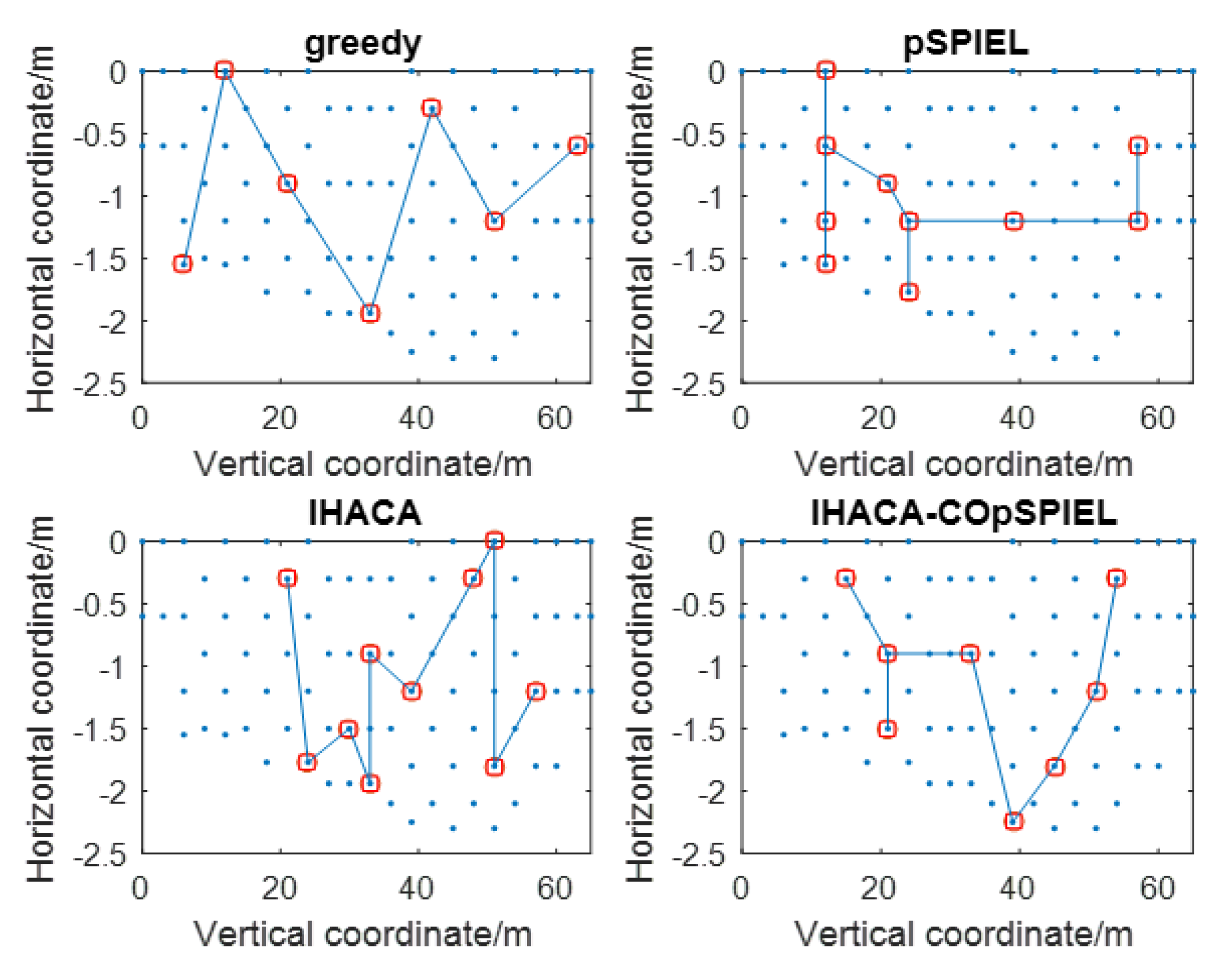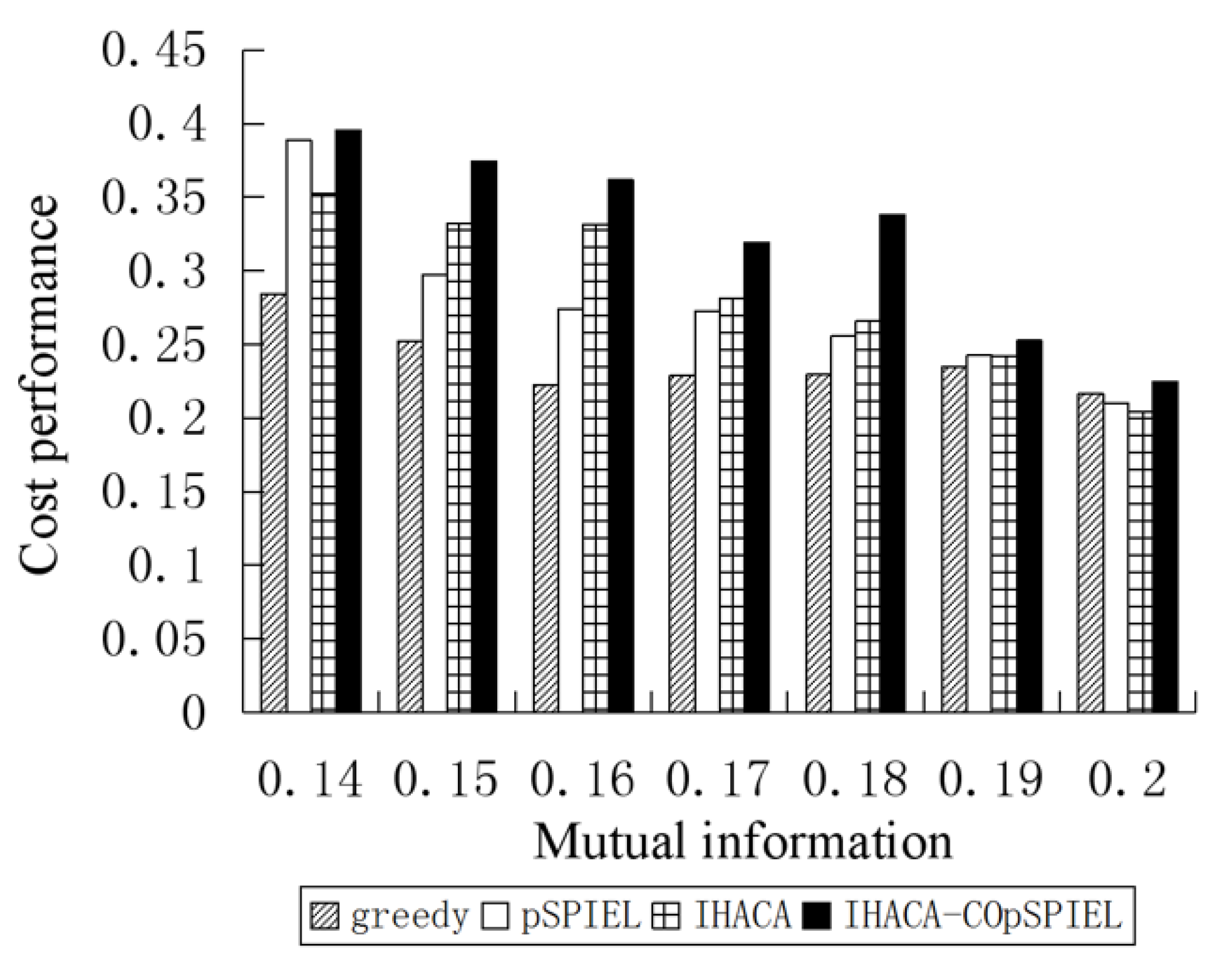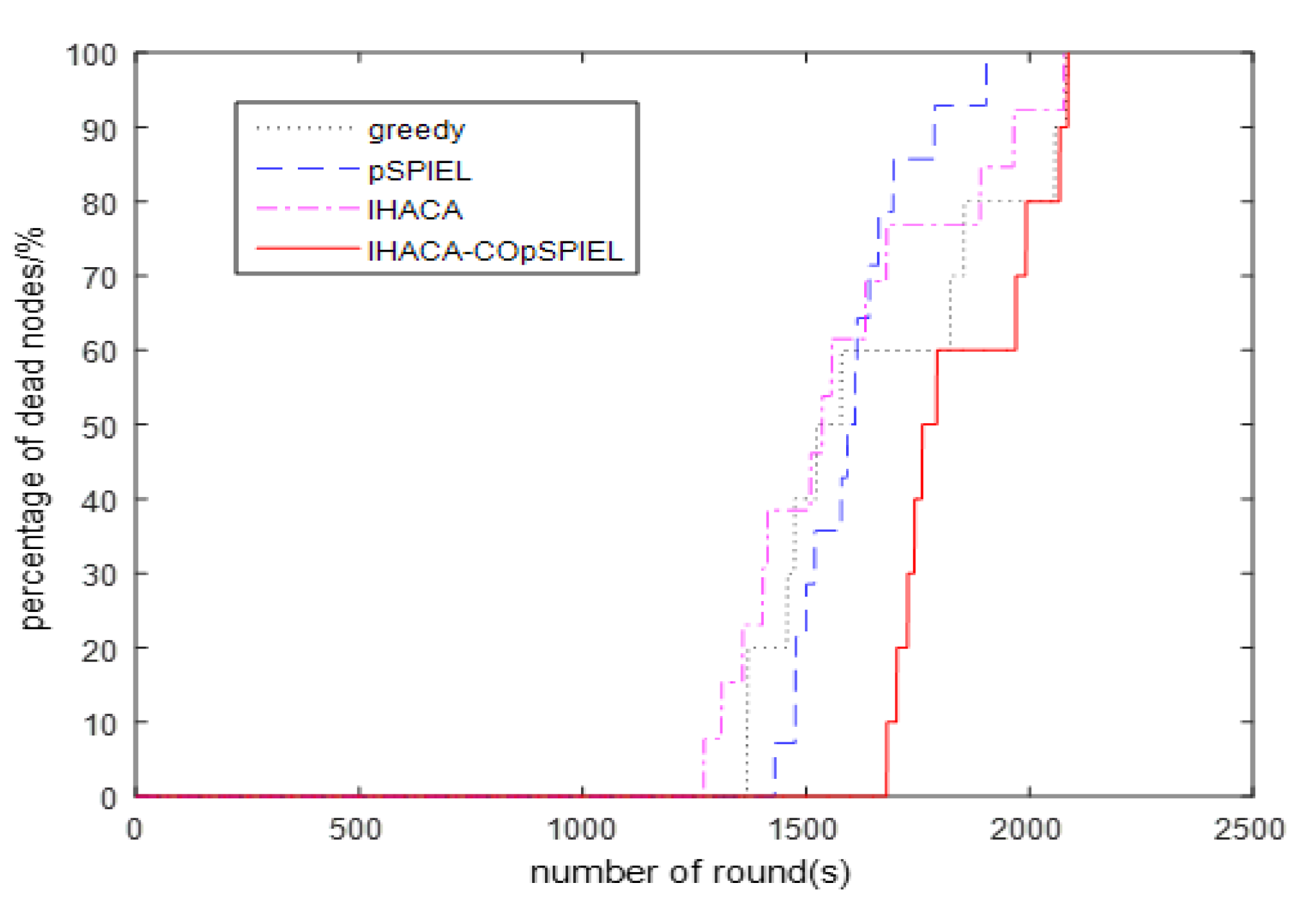Optimization of Submodularity and BBO-Based Routing Protocol for Wireless Sensor Deployment
Abstract
1. Introduction
2. Wireless Sensor Deployment Optimization
2.1. Wireless Sensor Deployment
2.1.1. Problem Description
2.1.2. Objective Function of Sensor Deployment Considering Communication Cost
2.2. IHACA-COpSPIEL Deployment Method
2.2.1. Chaos Optimized pSPIEL Algorithm
2.2.2. Improved Heuristic Ant Colony Algorithm
2.2.3. IHACA-COpSPIEL Algorithm
| Algorithm 1 Improved Heuristic Ant Colony Algorithm-Chaos Optimization of Padded Sensor Placements at Informative and cost-Effective Locations (IHACA-COpSPIEL). |
| Input: Position set V and covariance matrix |
| Output: Solution set A |
| 1: Initialize parameters: , , w, , , , |
| 2: Divide V into clusters |
| 3: each cluster |
| 4: Sort position points in by greedy algorithm and then get the ranks of |
| 5: Connect to form a chain which is then included into |
| 6: |
| 7: Uses as input of block-oriented algorithm to solve and then get the solution , |
| where = |
| 8: a given maximum mutural information in is not reached |
| 9: Select nodes for with greedy algorithm |
| 10: |
| 11: = |
| 12: n=1: |
| 13: a given maximum mutural information in is not reached |
| 14: Select IHACA initial points in from head nodes in |
| 15: Select next point with Equation (14) |
| 16: Update local pheromone with Equation (11) |
| 17: |
| 18: |
| 19: A= and output A |
| 20: |
| 21: |
| 22: Update global pheromone with Equation (12) |
| 23: |
| 24: A= and output A |
| 25: |
3. Routing Protocols for Wireless Sensor Networks
3.1. Communication Model
3.2. Optimal Clustering
3.3. Fitness Function
3.4. Routing Protocol Based on BBO Algorithm
| Algorithm 2 Biogeography-Based Optimization (BBO)-based routing protocol process. |
| Input: node coordinates, energy model |
| Output: residual energy per round, number of dead nodes, number of surviving nodes |
| 1: Initialize parameters: number of habitats n, maximum emigration rate E, maximum immigration rate I, |
| probability of species number for each habitat , maximum number of species , |
| maximum number of rounds |
| 2: l = 1: |
| 3: j = 1: n |
| 4: Select CH according to Equation (19) |
| 5: Initialize population randomly |
| 6: Calculate the fitness value of habitat j according to Equation (25) |
| 7: |
| 8: Keep habitat with the smallest fitness values as elite habitat |
| 9: habitat does not reach minimum fitness value |
| 10: k = 1: n |
| 11: Calculate the migration rate according to Equation (26) |
| 12: is greater than a uniformly distributed pseudo random number in [0,1] |
| 13: t = 1: n |
| 14: Calculate the migration rate according to Equation (27) |
| 15: is greater than a uniformly distributed pseudo random number in [0,1] |
| 16: The roulette selection method is used to select the population to move out of the habitat t |
| and move into the habitat k |
| 17: |
| 18: |
| 19: |
| 20: |
| 21: i = 1: n |
| 22: Habitat i is not an elite habitat |
| 23: Calculate the mutation rate according to Equation (28) |
| 24: is greater than a uniformly distributed pseudo random number in [0,1] |
| 25: Select population mutations in habitat i randomly |
| 26: |
| 27: |
| 28: |
| 29: Calculate fitness value |
| 30: Replace the worst habitats with elite habitats |
| 31: |
| 32: Calculate the shortest distance from ordinary nodes to CH |
| 33: Calculate the energy consumed by ordinary nodes to CH to transmit and receive data packets |
| 34: Calculate the energy consumed by CH to sink nodes to transmit and receive data packets |
| 35: Calculate the remaining energy, dead nodes, and surviving nodes of the sensor network |
| 36: All network nodes are dead |
| 37: |
| 38: |
| 39: |
| 40: |
4. Experimental Verification
4.1. Parameter Settings
4.2. Results and Analyses
5. Conclusions
Author Contributions
Funding
Acknowledgments
Conflicts of Interest
Abbreviations
| BBO | Biogeography-Based Optimization |
| IHACA | Improved Heuristic Ant Colony Algorithm |
| pSPIEL | padded Sensor Placements at Informative and cost-Effective Locations |
| IHACA-COpSPIEL | Improved Heuristic Ant Colony Algorithm-Chaos Optimization of padded Sensor |
| Placements at Informative and cost-Effective Locations | |
| SIVs | Suitable Index Variables |
References
- Hussein, A.A.; Khalid, R.A. An Improved Energy Efficient Chain-Based Routing Protocol Using Aco. Iraqi J. Inf. Commun. Technol. 2019, 2, 11–29. [Google Scholar] [CrossRef]
- Wang, Y.; Wang, L.; Chang, Q.; Yang, C. Effects of direct input–output connections on multilayer perceptron neural networks for time series prediction. Soft Comput. 2019, 1–10. [Google Scholar] [CrossRef]
- Aitsaadi, N.; Achir, N.; Boussetta, K.; Pujolle, G. Multi-objective WSN deployment: Quality of monitoring, connectivity and lifetime. In Proceedings of the IEEE International Conference on Communications, Cape Town, South Africa, 23–27 May 2010; pp. 1–6. [Google Scholar]
- Debbagh, M. Development of a Low-Cost Wireless Sensor Network for Passive in situ Measurement of Soil Greenhouse Gas Emissions. Ph.D. Thesis, McGill University, Montrea, QC, Canada, 2019. [Google Scholar]
- Kaddi, M.; Benahmed, K.; Boussetta, K.; Omari, M. A Novel Communication Mode for Energy-Efficient Based Chain in Wireless Sensor Networks. In International Conference in Artificial Intelligence in Renewable Energetic Systems; Springer: Cham, Switzerland, 2019; pp. 397–407. [Google Scholar]
- Caselton, W.F.; Zidek, J.V. Optimal monitoring network designs. Stat. Probab. Lett. 1984, 2, 223–227. [Google Scholar] [CrossRef]
- Niazadeh, R.; Roughgarden, T.; Wang, J. Optimal algorithms for continuous non-monotone submodular and dr-submodular maximization. In Advances in Neural Information Processing Systems; Springer: Cham, Switzerland, 2018; pp. 9594–9604. [Google Scholar]
- Ilves, K.; Harnefors, L.; Norrga, S.; Nee, H.P. Predictive sorting algorithm for modular multilevel converters minimizing the spread in the submodule capacitor voltages. IEEE Trans. Power Electron. 2014, 30, 440–449. [Google Scholar] [CrossRef]
- Krause, A. Optimizing Sensing: Theory and Applications. Ph.D. Thesis, Carnegie Mellon University, Pittsburgh, PA, USA, 2008. [Google Scholar]
- Huang, C.F.; Tseng, Y.C. The coverage problem in a wireless sensor network. Mob. Netw. Appl. 2005, 10, 519–528. [Google Scholar] [CrossRef]
- Guestrin, C.; Krause, A.; Singh, A.P. Near-optimal sensor placements in gaussian processes. In Proceedings of the 22nd International Conference on Machine Learning, Bonn, Germany, 7–11 August 2005; pp. 265–272. [Google Scholar]
- Cheng, H.; Su, Z.; Xiong, N. Energy-efficient node scheduling algorithms for wireless sensor networks using Markov Random Field model. Inf. Sci. 2016, 329, 461–477. [Google Scholar] [CrossRef]
- Krause, A.; Guestrin, C. Near-optimal Nonmyopic Value of Information in Graphical Models. In Proceedings of the Twenty-First Conference on Uncertainty in Artificial Intelligence, Edinburgh, UK, 26–29 July 2005; pp. 324–331. [Google Scholar]
- Coutino, M.; Chepuri, S.P.; Leus, G. Submodular sparse sensing for gaussian detection with correlated observations. IEEE Trans. Signal Process. 2018, 66, 4025–4039. [Google Scholar] [CrossRef]
- Xia, Y.; Wang, J. A Bi-Projection Neural Network for Solving Constrained Quadratic Optimization Problems. IEEE Trans. Neural Netw. Learn. Syst. 2016, 329, 214–224. [Google Scholar] [CrossRef]
- Zhang, S.; Xia, Y.; Wang, J. A complex-valued projection neural network for constrained optimization of real functions in complex variables. IEEE Trans. Neural Netw. Learn. Syst. 2015, 26, 3227–3238. [Google Scholar] [CrossRef]
- Liu, G.; Huang, X.; Guo, W.; Niu, Y.; Chen, G. Multilayer obstacle-avoiding x-architecture steiner minimal tree construction based on particle swarm optimization. IEEE Trans. Cybern. 2015, 45, 989–1002. [Google Scholar] [PubMed]
- Guo, W.; Li, J.; Chen, G.; Niu, Y.; Chen, C. A PSO-optimized real-time fault-tolerant task allocation algorithm in wireless sensor networks. IEEE Trans. Parallel Distrib. Syst. 2015, 26, 3236–3249. [Google Scholar] [CrossRef]
- Liu, X.; Zhao, S.; Liu, A.; Xiong, N.; Vasilakos, A.V. Knowledge-aware Proactive Nodes Selection approach for energy management in Internet of Things. Future Gener. Comput. Syst. 2019, 92, 1142–1156. [Google Scholar] [CrossRef]
- Heinzelman, W.R.; Kulik, J.; Balakrishnan, H. Adaptive protocols for information dissemination in wireless sensor networks. In Proceedings of the 5th annual ACM/IEEE International Conference on Mobile Computing and Networking, Seattle, WA, USA, 15–20 August 1999; pp. 174–185. [Google Scholar]
- HK, D.W.; Kurniawan, A.; Arifianto, M.S. Improving Topology of LEACH Cluster Using Reinforcement Learning Method. In Proceedings of the IEEE International Conference on Sensors and Nanotechnology, Penang Island, Malaysia, 24–25 July 2019; pp. 1–4. [Google Scholar]
- Daanoune, I.; Baghdad, A.; Balllouk, A. BRE-LEACH: A New Approach to Extend the Lifetime Of Wireless Sensor Network. In Proceedings of the Third International Conference on Intelligent Computing in Data Sciences (ICDS), Marrakech, Morocco, 28–30 October 2019; pp. 1–6. [Google Scholar]
- Simon, D. Biogeography-Based Optimization. IEEE Trans. Evol. Comput. 2008, 12, 702–713. [Google Scholar] [CrossRef]
- Nomosudro, P.; Mehra, J.; Naik, C.; Pushparaj, S.D. ECABBO: Energy-efficient clustering algorithm based on Biogeography optimization for wireless sensor networks. In Proceedings of the IEEE Region 10 Conference (TENCON), Kochi, India, 17–20 October 2019; pp. 828–834. [Google Scholar]
- Pal, R.; Pandey, H.M.A.; Saraswat, M. BEECP: Biogeography optimization-based energy efficient clustering protocol for HWSNs. In Proceedings of the Ninth International Conference on Contemporary Computing (IC3), Noida, India, 11–13 August 2016; pp. 1–6. [Google Scholar]
- Wang, Z.; Xie, H.; He, D.; Chan, S. Wireless Sensor Network Deployment Optimization Based on Two Flower Pollination Algorithms. IEEE Access 2019, 7, 180590–180608. [Google Scholar] [CrossRef]
- Wang, Z. Application of an Improved Ant Colony Algorithm in Coastal Tourism Route Optimization. J. Coast. Res. 2019, 98, 84–87. [Google Scholar]
- Kaveh, M.; Mesgari, M.S. Improved biogeography-based optimization using migration process adjustment: An approach for location-allocation of ambulances. Comput. Ind. Eng. 2019, 135, 800–813. [Google Scholar] [CrossRef]
- Saligheh, S.; Arasteh, B. Quality of Service Aware Service Composition Method Using Biogeography-Based Optimization (BBO) Algorithm. NASHRIYYAH -I MUHANDISI -I BARQ VA MUHANDISI -I KAMPYUTAR -I IRAN, B- MUHANDISI -I KAMPYUTAR 2019, 17, 190–198. [Google Scholar]






| Parameter | Description | Value |
|---|---|---|
| N | Total of location number for possibly-deployed sensors | 86 |
| Path weight | ||
| Heuristic information weight | ||
| Local pheromone evaporation coefficient | ||
| Global information system evaporation coefficient | ||
| w | Weight | |
| Q | Pheromone quality coefficient | 1 |
| Pheromone under initial conditions | ||
| Constant | 1 | |
| Probability that habitat i has species s | ||
| Maximum of | 1 | |
| I | Maximum immigration rate | 1 |
| E | Maximum emigration rate | 1 |
| Sensor node’s initial energy | 0.5 J | |
| Energy consumption per bit for transmitting data | 50 nJ/bit | |
| Energy consumption of multipath model transmitter | 0.013 pJ/bit/m | |
| Energy consumption of free space model transmitter | 10 pJ/bit/m | |
| Maximum round number | 2500 | |
| Maximum iteration number | 100 |
| Mutual Information | Communication Cost | |||
|---|---|---|---|---|
| Greedy | pSPIEL | IHACA | IHACA-COpSPIEL | |
| 0.14 | 49.22 | 36.01 | 39.7 | 35.42 |
| 0.15 | 59.47 | 50.4 | 45.16 | 40.06 |
| 0.16 | 71.83 | 58.34 | 48.24 | 44.23 |
| 0.17 | 74.31 | 62.44 | 60.36 | 53.26 |
| 0.18 | 78.48 | 70.43 | 67.75 | 64.11 |
| 0.19 | 80.82 | 78.28 | 78.41 | 75.22 |
| 0.20 | 98.57 | 95.21 | 97.76 | 89.05 |
| Mutual Information | Sensor Number | |||
|---|---|---|---|---|
| Greedy | pSPLIE | IHACA | IHACA-COpSPIEL | |
| 0.14 | 5 | 6 | 7 | 6 |
| 0.15 | 6 | 8 | 8 | 7 |
| 0.16 | 7 | 10 | 10 | 8 |
| 0.17 | 10 | 13 | 12 | 10 |
| 0.18 | 12 | 14 | 13 | 12 |
| 0.19 | 17 | 25 | 25 | 20 |
| 0.20 | 25 | 30 | 30 | 28 |
© 2020 by the authors. Licensee MDPI, Basel, Switzerland. This article is an open access article distributed under the terms and conditions of the Creative Commons Attribution (CC BY) license (http://creativecommons.org/licenses/by/4.0/).
Share and Cite
Wang, Y.; Duan, Y.; Di, W.; Chang, Q.; Wang, L. Optimization of Submodularity and BBO-Based Routing Protocol for Wireless Sensor Deployment. Sensors 2020, 20, 1286. https://doi.org/10.3390/s20051286
Wang Y, Duan Y, Di W, Chang Q, Wang L. Optimization of Submodularity and BBO-Based Routing Protocol for Wireless Sensor Deployment. Sensors. 2020; 20(5):1286. https://doi.org/10.3390/s20051286
Chicago/Turabian StyleWang, Yaoli, Yujun Duan, Wenxia Di, Qing Chang, and Lipo Wang. 2020. "Optimization of Submodularity and BBO-Based Routing Protocol for Wireless Sensor Deployment" Sensors 20, no. 5: 1286. https://doi.org/10.3390/s20051286
APA StyleWang, Y., Duan, Y., Di, W., Chang, Q., & Wang, L. (2020). Optimization of Submodularity and BBO-Based Routing Protocol for Wireless Sensor Deployment. Sensors, 20(5), 1286. https://doi.org/10.3390/s20051286






